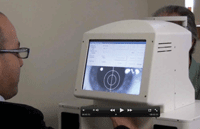The eye may one day soon hold the key to earlier diagnosis of Alzheimer’s disease, according to the results of research trials reported at the recent Alzheimer’s Association International Conference.
In one study, volunteers took a proprietary supplement containing curcumin, which binds to amyloid-beta and allows amyloid plaques to be detected in the eye using a novel system and a technique called retinal amyloid imaging.1
Investigators shared preliminary results, which suggest that amyloid levels detected in the retina were significantly correlated with brain amyloid levels as shown by positron emission tomography (PET) imaging. The retinal amyloid test also differentiated between Alzheimer’s and non-Alzheimer’s subjects with 100% sensitivity and 81% specificity.

| |
|
A novel fluorescent ligand eye scanning system detects amyloid-beta, indicative of Alzheimer's disease, in the lens of the eye. Photo: Cognoptix Inc.
|
Using results from the fluorescent imaging, researchers were able to differentiate people with Alzheimer’s from healthy controls with high sensitivity (85%) and specificity (95%). Amyloid levels based on the eye lens test correlated significantly with results obtained through PET brain imaging.
Currently, there is no definitive technique for diagnosing Alzheimer’s. The diagnosis is usually made through a series of cognitive and neurological tests, as well as brain imaging.
“There is an urgent need for a low cost, non-invasive test for early detection of Alzheimer’s disease. We are moving aggressively forward in clinical development to make our technology available worldwide,” says Paul Hartung, CEO of Cognoptix, the company behind the fluorescent ligand eye scanning system.
See also “What to Say About Alzheimer’s,” page 70.
1. Frost S, Kanagasingam Y, Macaulay L, et al. Retinal amyloid fluorescence imaging predicts cerebral amyloid burden and Alzheimer’s disease. Presented at the Alzheimer’s Association International Conference, July 15, 2014; Copenhagen, Denmark.
2. Hartung PD, Kerbage C, Sadowsky C, et al. Detection of ligand bound to beta amyloid in the lenses of human eyes. Presented at the Alzheimer’s Association International Conference, July 14, 2014; Copenhagen, Denmark.

